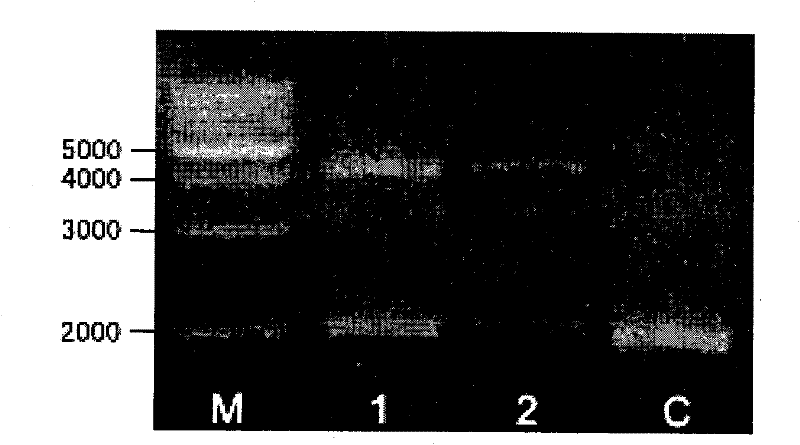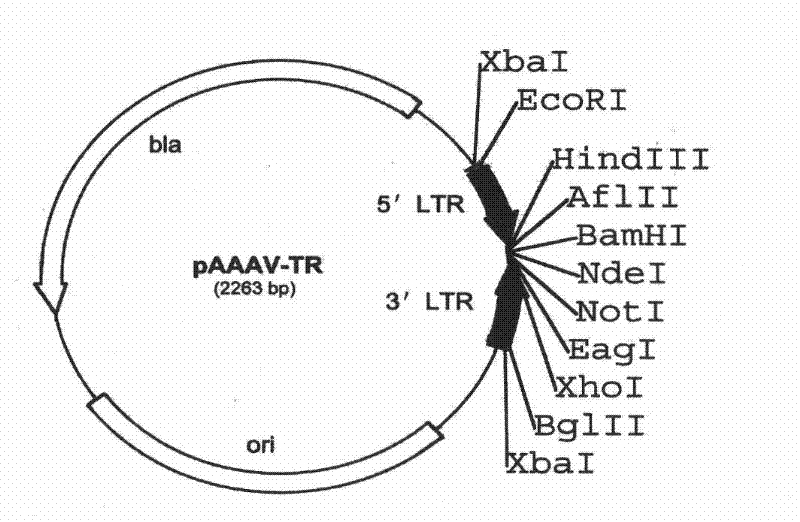Method for genetic targeting of stem spermatogonium of poultry
A spermatogonial stem cell and gene targeting technology, which can be used in microorganism-based methods, genetic engineering, plant genetic improvement, etc. short, non-pathogenic effect
- Summary
- Abstract
- Description
- Claims
- Application Information
AI Technical Summary
Problems solved by technology
Method used
Image
Examples
Embodiment 1
[0038] Example 1: Construction of AAAV gene transfer vector (pAAAV-TR).
[0039] The basic skeleton of the AAAV transfer vector is obtained by PCR amplification of the pTRE-tight-B1 plasmid (purchased from Clontech Company), and the primer sequences are respectively:
[0040] Primer 1: aa aagctt aaggatccatatgcggccg ctcgag aac agatct aGAGCTTCCTCGCTCACTGACTCG, the lowercase letters are the introduced multiple cloning sites, and the underlines indicate the HindIII, XhoI, and BglII sites in turn.
[0041] Primer 2: ttt gaattc The lowercase letters of tagACGTCAGGTGGCACTTTTC are the restriction restriction sites introduced, and the underline indicates the EcoR I site.
[0042] The reaction system for PCR was 20 μL, including: 10 ng plasmid DNA, 2 μl 10×LA PCR buffer, 0.4 mM dNTPs, 10-primers, and 2 units of TaKaRa LATaq DNA polymerase (purchased from TaKaRa Company). The PCR reaction conditions were: denaturation at 94°C for 2 minutes; 32 cycles at 94°C for 30s, 56°C for 30...
Embodiment 2
[0044] Example 2: Amplification of HS4 and construction of pMD19-2HS4 plasmid.
[0045] Design primers based on chicken HS4 sequence (GenBank_NW 001471556 293787-294082):
[0046] Primer 3: CCGCGGG TGATCA CGGGGAGAG is underlined to indicate the Bcl I site
[0047] Primer 4: TTCAGCCT AGATCT TTTTCCCCGTA is underlined to indicate the BglII site
[0048] PCR is a 20 μL reaction system including: 50 ng chicken genomic DNA, 10 μl 2×GC buffer, 0.4 mM dNTPs, 10 μM primers, and 2 units of TaKaRa LATaq DNA polymerase (purchased from TaKaRa Company). The PCR reaction conditions were: denaturation at 94°C for 1 min; 30 cycles at 94°C for 30 s, 63°C for 30 s, and 72°C for 1 min, and finally extension at 72°C for 5 min. The PCR product was TA cloned into the pMD19-T vector (purchased from TaKaRa Company), transfected with JM109 competent bacteria, and 5 clones were taken to extract plasmids, which were digested with Bcl I and HindIII respectively, and the plasmid containing the insert...
Embodiment 3
[0049] Example 3: Construction of chicken ovalbumin gene targeting vector.
[0050] Referring to GenBank J00895, the following primers were designed to amplify the full sequence of chicken ovalbumin gene: primer 5, 29bp 5′AAC ATT TAC TGG GAA GCA CAT CTA TCA TC 3′; primer 6, 28bp 5′GGA CTC TTGTTC AAC TTC TCA CCC ACT A 3 'The product is 9016bp. PCR is 20 μL reaction system including: 50ng genomic DNA, 2μl 10×LA PCR buffer, 0.4mM dNTPs, 10μM primers, 2 units of TaKaRa LATaq DNA polymerase (TaKaRa). The PCR reaction conditions were: denaturation at 94°C for 2min; 35 cycles at 94°C for 30s, 69°C for 6min, and finally extension at 72°C for 10min. The PCR product was diluted 1000 times for use.
[0051] See Table 1 for the design of PCR amplification primers and templates for each component of the gene targeting vector. (The pSUPER plasmid is a product of OligoEngine. For the pL-GFP plasmid construction method, see Journal of Nanjing Agricultural University 2008, 3(3): 97-101.)
...
PUM
 Login to View More
Login to View More Abstract
Description
Claims
Application Information
 Login to View More
Login to View More - R&D
- Intellectual Property
- Life Sciences
- Materials
- Tech Scout
- Unparalleled Data Quality
- Higher Quality Content
- 60% Fewer Hallucinations
Browse by: Latest US Patents, China's latest patents, Technical Efficacy Thesaurus, Application Domain, Technology Topic, Popular Technical Reports.
© 2025 PatSnap. All rights reserved.Legal|Privacy policy|Modern Slavery Act Transparency Statement|Sitemap|About US| Contact US: help@patsnap.com



